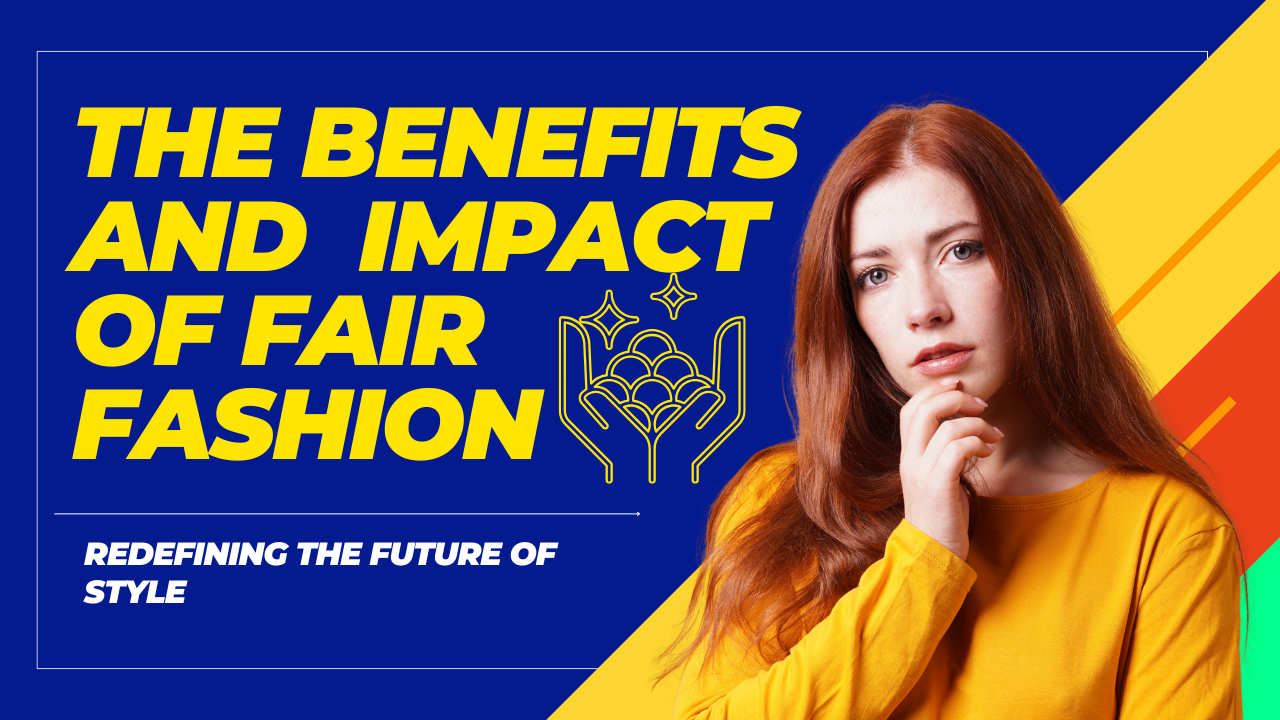
In an era of climate change, social inequality, and over consumption, fair fashion has emerged as a trans formative movement. It doesn’t simply redefine clothing; it reshapes values. By prioritising ethical lobar, environmental protection, and transparency, fair fashion offers a new blueprint for a just and sustainable future.
Here are the key benefits and impacts of fair fashion that highlight why this movement matters now more than ever.
One of the most significant benefits of fair fashion is its commitment to fair wages and safe working conditions.
Traditional fast fashion supply chains exploit millions of workers—mostly women—in developing countries. These individuals often endure long hours, unsafe environments, and below-subsistence pay.
Fair fashion brands, on the other hand, ensure that workers are paid living wages, have secure employment, and work in safe, regulated facilities.
Impact:
Improves the quality of life for garment workers and their families.
Supports gender equality by empowering women through stable income.
Reduces child lb or and unethical Tabor practices.
When workers are treated with dignity, it fosters long-term economic stability and promotes respect across the global fashion ecosystem.
The environmental benefits of fair fashion are profound. The global fashion industry is one of the largest polluters, responsible for roughly 10% of total carbon emissions and immense water consumption.
Fair fashion reduces this footprint by promoting:
Organic materials such as organic cotton, bamboo, and hemp.
Recycled fabrics that minimise waste.
Low-impact dyes and Eco-friendly manufacturing processes.
Impact:
Reduction in water and energy consumption.
Decrease in toxic chemical use and waterway pollution.
Less textile waste through recycling and up cycling.
Ultimately, fair fashion nurtures a circular economy, where materials are reused and regenerated instead of discarded.
Another major benefit of fair fashion is transparency. In traditional fashion, consumers rarely know where their clothes come from or who made them. Fair fashion changes that narrative.
Ethical brands openly disclose information about:
Factory locations and working conditions.
Material sourcing and certifications.
Environmental and social impact reports.
Impact:
Builds stronger trust between brands and consumers.
Encourages accountability and honesty within the fashion industry.
Empowers consumers to make informed, conscious purchasing decisions.
Transparency not only builds credibility but also drives industry-wide reform as consumers increasingly demand openness.
Fair fashion often collaborates with local artisans and craftspeople, preserving cultural heritage while generating economic opportunity. Traditional weaving, embroidery, and dyeing techniques are integrated into modern designs, giving artisans a global platform.
Impact:
Revives and sustains traditional art forms.
Promotes local employment and entrepreneurship.
Reduces dependency on exploitative multinational production chains.
Through this, fair fashion acts as both a cultural preservation tool and a socioeconomic development model for underrepresented communities.
Fast fashion thrives on overproduction and waste. Fair fashion promotes a circular economy, where clothes are designed for longevity, repair ability, and irreconcilability.
Impact:
Extends the life cycle of clothing through repair, resale, and recycling.
Reduces landfill waste and carbon emissions.
Encourages innovation in sustainable textile technologies.
The circular model challenges the harmful “take–make–dispose” system and replaces it with a regenerative, restorative approach to fashion.
While often overlooked, fair fashion also benefits consumer psychology. Wearing clothes made ethically can create a sense of pride, confidence, and emotional satisfaction.
Impact:
Enhances emotional connection with products.
Promotes mindful consumption habits.
Reduces guilt and “fast fashion fatigue.”
Fair fashion encourages consumers to value quality, story, and purpose over quantity — leading to a more fulfilling relationship with personal style.
Fair fashion directly supports several United Nations Sustainable Development Goals (Sags), making it a key contributor to global progress.
Key Sags Impacted:
SAG 5: Gender Equality
SAG 8: Decent Work and Economic Growth
SDG 12: Responsible Consumption and Production
SAG 13: Climate Action
Impact:
Strengthens the link between fashion and social responsibility.
Encourages global policy alignment with sustainability standards.
Inspires other industries to follow similar ethical frameworks.
Fair fashion is driving innovation in materials, technology, and supply chain design.
From bio-fabricated leather to blockchain-based tracking, these innovations not only reduce environmental harm but also improve business efficiency.
Impact:
Encourages collaboration between designers, technologists, and environmentalists.
Sets new industry benchmarks for accountability and creativity.
Positions fair fashion as the future-forward leader of the apparel industry.
In the long term, innovation ensures that fair fashion remains callable, practical, and economically viable.
Fair fashion is far more than a niche concept — it is a global necessity. Its benefits span from individual empowerment to planetary preservation, from cultural continuity to technological progress.
By supporting fair fashion, we are investing in a world where style and conscience coexist, where beauty is not built on exploitation, and where every garment tells a story of respect and resilience.
In a rapidly changing world, the true measure of fashion’s success is no longer speed or trendiness — it’s fairness.
Fashion Revolution. (2023). Fashion Transparency Index 2023. Retrieved from https://www.fashionrevolution.org
United Nations Environment Programme (NEPTUNE). (2022). Sustainability and Circularity in the Textile Value Chain. Retrieved from https://www.unep.org
Clean Clothes Campaign. (2021). Global Garment Workers Report. Retrieved from https://cleanclothes.org
World Bank. (2022). How Much Do Our Wardrobes Cost to the Environment? Retrieved from https://www.worldbank.org
Nielsen. (2019). Sustainable Consumption Report. Retrieved from https://www.nielsen.com
Global Organic Textile Standard (TOGS). (2024). Certification Guidelines for Organic Textiles. Retrieved from https://global-standard.org
United Nations Alliance for Sustainable Fashion. (2021). Sags and the Fashion Industry. Retrieved from https://unfashionalliance.org
Patagonia. (2023). Environmental and Social Responsibility Report. Retrieved from https://www.patagonia.com

Share This News